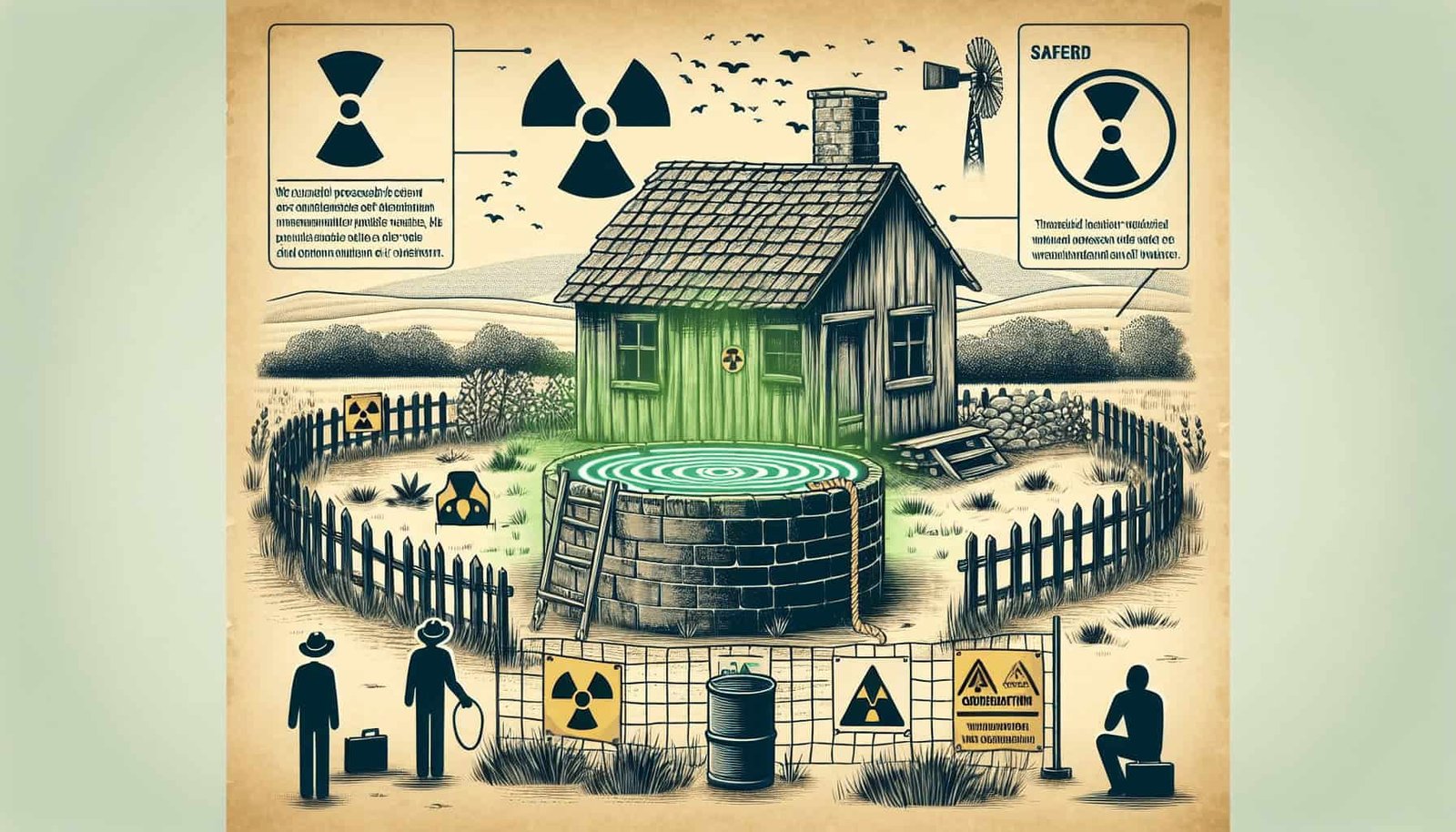In this article, we will explore the potential risks associated with excessive well water that contains high levels of tritiated water. Tritiated water is water that contains a radioactive form of hydrogen called tritium, which can be found naturally in groundwater or as a result of human activities. By understanding the dangers that may be lurking within our wells, we can take necessary precautions to protect our health and well-being. So, let’s dive into the potential hazards and what they mean for you.
Health Effects of Tritiated Water
Tritiated water refers to water that contains an elevated level of tritium, a radioactive isotope of hydrogen. Exposure to tritiated water carries various health risks, primarily due to its potential to cause cellular damage and interfere with essential biological functions. It is essential to understand these health effects to mitigate the risks associated with tritiated water exposure.
Increased Risk of Cancer
One of the most significant concerns associated with exposure to tritiated water is the increased risk of developing cancer. Tritium emits low-energy beta radiation, which can penetrate the body’s tissues and cells. When tritium decays, it releases this radiation, which can damage the genetic material (DNA) in cells. Prolonged exposure to tritiated water has been linked to an increased likelihood of developing various types of cancer, including cancers of the liver, bone, and lung.
Potential Damage to DNA
Tritiated water’s radioactivity makes it capable of damaging DNA, the building blocks of life. When tritium undergoes decay, the high-speed beta particles it emits can disrupt the structure of DNA molecules, leading to mutations. These mutations, if not successfully repaired by the body’s mechanisms, can result in genetic alterations that may cause diseases or impair normal cellular functions. The potential damage to DNA underscores the importance of minimizing exposure to tritiated water.
Disruption of Cellular Function
The presence of tritiated water within cells can interfere with their normal biological functions. Tritium’s radiation can disrupt cellular processes, such as DNA replication and protein synthesis, leading to cellular dysfunction. Additionally, the radiation emitted by tritium can ionize molecules within cells, causing chemical and molecular changes that further disrupt cellular function. These disruptions can have far-reaching effects on overall health and well-being.
Environmental Impact
Beyond its implications for human health, tritiated water also poses environmental concerns due to its potential to contaminate various ecosystems.
Contamination of Soil and Groundwater
Industrial and nuclear facilities that handle tritium may release tritiated water into the environment, leading to contamination of soil and groundwater. Once tritium enters the soil, it can infiltrate groundwater sources, potentially affecting drinking water supplies. This contamination jeopardizes the health and well-being of both wildlife and humans, highlighting the need for robust environmental monitoring and remediation efforts.
Impact on Aquatic Ecosystems
Aquatic ecosystems, including rivers, lakes, and oceans, can be significantly impacted by the presence of tritiated water. Fish and other aquatic organisms can absorb tritium through their gills or via consumption of contaminated plants and prey. The radiation emitted by tritium can affect these organisms’ health and reproductive capabilities, ultimately disrupting the delicate balance of aquatic ecosystems. Protecting these ecosystems from tritium contamination is essential to maintain biodiversity and ensure the long-term sustainability of aquatic resources.
Effect on Plant Growth
Tritiated water’s impact on plant growth is another critical consideration. Plants can take up tritium through their roots or from moisture in the air. Once absorbed, tritium can interfere with various physiological processes, including photosynthesis and nutrient uptake. These disruptions can impair plant growth, reduce crop yields, and compromise the overall health of terrestrial ecosystems. Monitoring tritium levels in agricultural areas is crucial to safeguarding food security and protecting the environment.

Legal and Regulatory Considerations
To protect public health and the environment, legal and regulatory frameworks govern the permissible levels of tritiated water in various contexts.
Maximum Contaminant Levels
Regulations establish maximum contaminant levels (MCLs) for tritium in drinking water to ensure its safety for human consumption. These MCLs are set based on the current scientific understanding of tritium’s health risks and take into account the potential for cumulative exposure over time. Regular testing of drinking water supplies helps ensure compliance with these MCLs and allows for prompt action if contamination is detected.
Safe Drinking Water Act Compliance
In the United States, tritiated water falls under the purview of the Safe Drinking Water Act (SDWA). This legislation sets standards and guidelines for maintaining the quality of drinking water sources and facilitates the implementation of monitoring and mitigation strategies. Compliance with the SDWA is crucial to protect public health and ensure the provision of safe drinking water to communities across the country.
Risk Assessment and Mitigation Strategies
A robust risk assessment framework is essential to identify potential sources of tritium contamination and evaluate associated risks. Regulatory agencies work alongside industries and facilities that handle tritium to identify appropriate mitigation measures and technologies. This collaboration ensures responsible management of tritium-containing materials and minimizes the risks posed to human health and the environment.
Testing and Monitoring Protocols
Regular testing and monitoring of tritium levels in water sources are fundamental in assessing contamination risks and implementing appropriate measures.
Regular Water Quality Testing
Water quality testing, including tritium analysis, is crucial in monitoring tritium levels and identifying potential contamination sources. Routine testing allows for early detection of elevated tritium levels, triggering timely action to minimize exposure risks. Water utilities, environmental agencies, and other stakeholders must collaborate to implement comprehensive and frequent testing protocols.
Analyzing Tritium Concentration Levels
Accurate analysis of tritium concentration levels in water samples is vital for assessing contamination risks and defining appropriate responses. Analytical techniques, such as liquid scintillation counting and mass spectrometry, are commonly used to determine tritium concentrations. Ensuring the reliability and consistency of these analytical methods is crucial for accurate risk assessment.
Monitoring Groundwater Contamination
Given the potential for tritium to infiltrate groundwater, monitoring programs should be established to track its presence in aquifers and wells. Frequent sampling and analysis of groundwater sources allow for early detection of contamination and the implementation of measures to prevent further spread. Regular monitoring helps ensure the protection of drinking water supplies and the preservation of groundwater ecosystems.

Health Risks for Vulnerable Populations
Certain population groups are particularly vulnerable to the health risks associated with tritiated water exposure. Special attention must be given to safeguarding their well-being.
Pregnant Women and Developing Fetus
Pregnant women and their developing fetuses are especially sensitive to the effects of radiation. Tritium’s ability to traverse the placental barrier means that exposure can potentially harm fetal development and increase the risk of long-term health issues. Pregnant women should be cautious about their water sources and consult with healthcare professionals to minimize exposure risks.
Infants and Young Children
Infants and young children also face heightened risks from tritiated water exposure. Their rapidly developing bodies and immune systems are more susceptible to the adverse effects of radiation. Strict adherence to safe drinking water guidelines and the use of appropriate treatment technologies are crucial in protecting the health of these vulnerable populations.
Individuals with Weakened Immune Systems
Individuals with weakened immune systems, such as those undergoing chemotherapy or organ transplantation, are more susceptible to the health effects of tritiated water exposure. Their compromised ability to repair DNA damage increases the likelihood of adverse outcomes. Additional precautions should be taken to minimize their exposure to tritium, including the use of alternative water sources or enhanced treatment processes.
Methods for Tritium Removal
Various methods can be employed to remove tritium from water sources, ensuring safe and clean drinking water for communities.
Distillation and Evaporation
Distillation and evaporation techniques can be used to separate tritium from water by vaporization. This method relies on the distinct boiling points of tritium and water, enabling their separation. However, distillation and evaporation may not be suitable for large-scale water treatment due to energy requirements and infrastructure constraints.
Ion Exchange
Ion exchange involves using resins, such as zeolites, to remove tritium ions from water by exchanging them with less radioactive ions. This method effectively reduces tritium concentration but requires periodic replacement or regeneration of the resins.
Electrolysis
Electrolysis can be utilized to remove tritium from water by inducing a chemical reaction that separates tritium molecules. This process relies on the application of an electric current to split water molecules into hydrogen and oxygen gases. However, electrolysis is an energy-intensive method and may not be feasible for large-scale treatment applications.
Catalytic Exchange
Catalytic exchange relies on the use of catalysts to promote the exchange of tritium with non-radioactive hydrogen. This method can effectively reduce tritium levels in water but may require the optimization of catalyst materials and conditions to achieve maximum efficiency.

Potential Contamination Sources
Tritiated water can arise from various contamination sources, both human-made and natural, highlighting the need for proactive monitoring and preventive measures.
Industrial and Nuclear Facilities
Industrial and nuclear facilities that handle tritium as part of their operations pose a significant potential source of contamination. Accidental releases, poor waste management practices, or inadequate storage facilities can lead to the release of tritiated water into the environment, with far-reaching consequences for human health and ecosystems.
Accidental Spills and Leaks
Accidental spills and leaks can also result in tritium contamination. For instance, transportation accidents involving tritium-containing materials can lead to the release of tritiated water into soil, groundwater, or surface water sources. Prompt response and effective containment efforts are essential in minimizing the impacts of such incidents.
Natural Occurrence
While most of the concerns surrounding tritium focus on human-made sources, it is worth noting that tritium can occur naturally in the environment as a result of cosmic rays interacting with atmospheric gases. Although natural tritium levels are generally low, local variations can occur, leading to increased exposure risks in some areas. Monitoring and understanding these natural occurrences are essential for accurate risk assessment.
Community Responses and Support
Communities have an important role to play in mitigating the risks associated with tritiated water through education, collaboration, and investment in water treatment initiatives.
Public Awareness and Education
Raising public awareness about the potential risks of tritiated water is crucial in fostering informed decision-making and encouraging responsible water consumption practices. Educational campaigns can focus on the health effects of tritium, the importance of safe drinking water, and the available resources for water quality testing and treatment.
Community Water Treatment Initiatives
Communities can come together to establish water treatment initiatives that aim to remove tritium from local water sources. Collaborative efforts can include investments in appropriate treatment technologies, community-based monitoring programs, and the development of alternative water sources to ensure a sustainable and safe water supply.
Collaboration with Environmental Organizations
Engaging with environmental organizations can provide valuable support to communities dealing with tritiated water issues. These organizations often possess expertise in water quality monitoring, advocacy, and public health outreach. Together, communities and environmental organizations can advocate for stricter regulations, influence policy decisions, and contribute to the ongoing research and development of innovative treatment technologies.

Long-term Health Impacts
Understanding the long-term health impacts of tritiated water exposure is essential in assessing risks and implementing necessary preventative measures.
Cumulative Exposure Effects
Exposure to tritiated water over an extended period can result in cumulative health effects. The continuous decay of tritium and the associated beta radiation can lead to persistent DNA damage and an increased risk of cancer. Monitoring and limiting cumulative exposure through stringent regulations and contamination prevention is vital for protecting public health.
Chronic Health Conditions
In addition to cancer, prolonged exposure to tritiated water has been associated with the development of chronic health conditions. These conditions can include organ dysfunction, reproductive issues, and immune system disorders. Long-term medical monitoring and follow-up are necessary to identify and manage these potential health risks effectively.
Medical Monitoring and Follow-up
Individuals who have been exposed to tritiated water, especially in high concentrations, should undergo medical monitoring and follow-up to detect any potential health issues early. Regular check-ups, screenings, and assessments by healthcare professionals can help identify any emerging conditions and provide appropriate treatment or management strategies.
Future Research and Development
Continued research and development efforts are essential to address the challenges posed by tritiated water and identify innovative solutions to ensure water safety.
Improved Tritium Detection Methods
Efforts should focus on developing more accurate and sensitive methods for detecting and quantifying tritium levels in water. Ongoing research can help refine existing analytical techniques or explore new approaches that improve detection limits, reduce analysis time, and enhance reliability.
Alternative Water Sources
Exploring alternative water sources can provide communities with additional options for accessing safe drinking water. Research into innovative water supply systems, such as rainwater harvesting or decentralized treatment technologies, can help diversify water sources and reduce reliance on potentially contaminated groundwater.
Innovative Treatment Technologies
Research and development should also focus on advancing treatment technologies for removing tritium from water. This includes exploring new materials, improving existing processes, and optimizing treatment systems to achieve more efficient and cost-effective removal of tritium. These innovative technologies will play a crucial role in safeguarding water supplies and protecting human health and the environment.
In conclusion, tritiated water poses significant risks to human health and the environment. The increased risk of cancer, potential damage to DNA, and disruption of cellular function underscore the importance of minimizing exposure to tritiated water. Contamination of soil and groundwater, impact on aquatic ecosystems, and effect on plant growth highlight the environmental concerns associated with tritium release. Legal and regulatory considerations, such as maximum contaminant levels and compliance with the Safe Drinking Water Act, aim to protect public health. Testing and monitoring protocols, along with methods for tritium removal, provide avenues for ensuring safe water supplies. Vulnerable populations, including pregnant women, infants, and individuals with weakened immune systems, require special attention. Community responses and support can contribute to public awareness, water treatment initiatives, and collaboration with environmental organizations. Understanding the long-term health impacts, such as cumulative exposure effects and chronic health conditions, emphasizes the need for ongoing medical monitoring and follow-up. Finally, future research and development efforts should focus on improved detection methods, alternative water sources, and innovative treatment technologies to safeguard water resources for generations to come.

